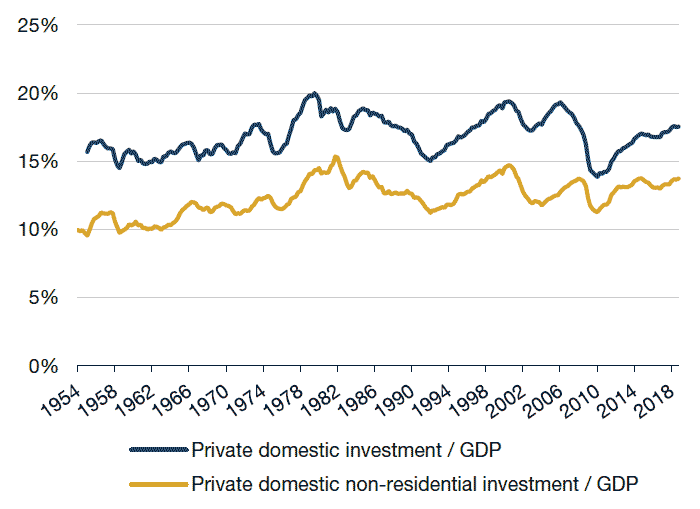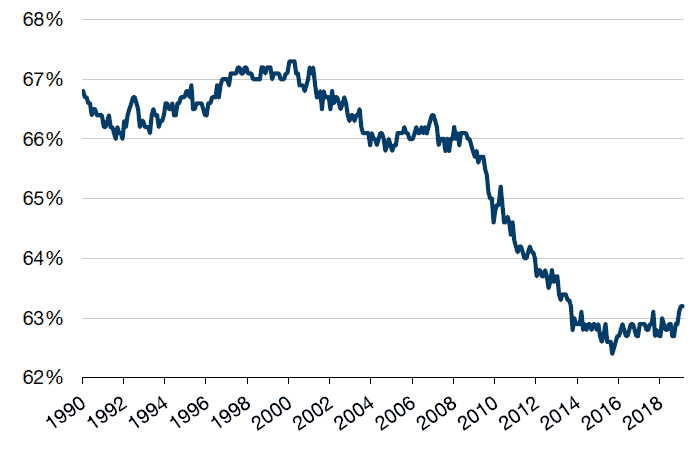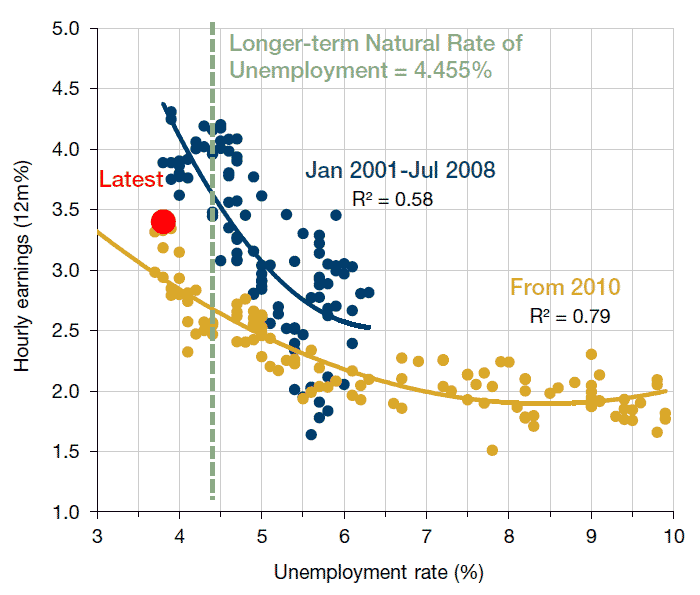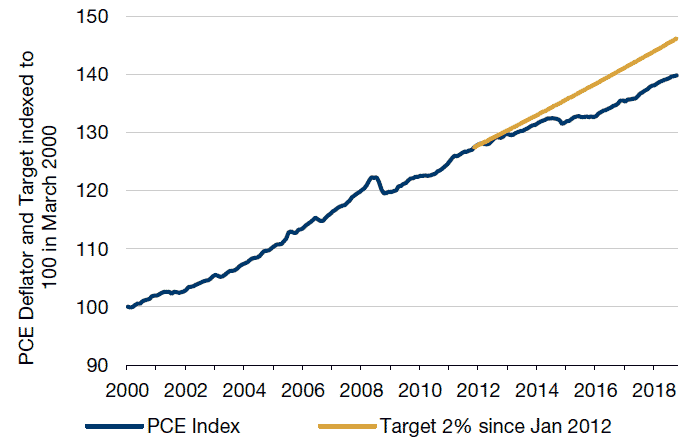Two new possible policy initiatives risk unmooring inflation expectations, changing our inflation regime from Reflation to Inflation.
Two new possible policy initiatives risk unmooring inflation expectations, changing our inflation regime from Reflation to Inflation.
April 2019

Introduction
Policymakers are looking at the deflation endgame. In the last decade, we have been treated to a real-life demonstration of the possibilities of macro-economic policy that our parents’ generation would scarcely have believed. Growing up, we were used to central banks moving interest rates around, conducting open market operations, opining on the odd merger or two, but little more than that.
However, since Ben Bernanke set out a list – in his 2002 “helicopters” speech – of all the possible weapons a central bank has in its armoury beyond taking rates to the zero lower bound (and of course even the zero lower bound has been breached), it’s amazing to consider that nearly everything on that list has been put into practice somewhere in the world. Thus, we have seen:
- Inflation targeting;
- Macro-prudential policy;
- Zero interest-rate policy;
- Yield curve control;
- Forward guidance;
- Purchase of high-quality assets;
- Purchase of lower-quality assets;
- Purchase of troubled assets;
- Long-term refinancing operations (‘LTROs’);
- FX targeting by buying foreign assets (although this is routinely denied).
In this article, we look at what’s left to policymakers. Price level targeting and fiscal quantitative easing (‘QE’) are two policies that seem increasingly likely to be tried next, in our view. We feel the danger is that if both were deployed, they may work too well, leaving inflation expectations unanchored. This would move our Fire & Ice inflation regime from Reflation into Inflation, and would necessitate substantial cuts to both our equity and bond weights. On balance, we feel that these last steps are most likely to be taken only during the next recession or crisis. So, we feel it’s far too soon to make these moves, but vigilance is called for as we continue to monitor the potential threat of deflation.
Are We Still in Secular Stagnation?
It’s been five years since Larry Summers first resuscitated Alvin Hansen’s expression of post-crisis angst, encapsulated in his phrase “secular stagnation.” Hansen’s idea was that the US economy was likely to suffer a long period of below-trend growth and inflation as the private sector attempted to deleverage and the banking system to recapitalise after the Great Depression.
Summers set out, in his 2014 speech, the three factors that he believed had contributed to what he identified as a new bout of torpor: he attributed half the presumed decline in potential output growth to lower capital investment; 40% to a fall in hours worked; and 10% to falling total factor productivity, which he attributed to technological change.
As the US economy has slowly recovered from the Great Financial Crisis (‘GFC’), it’s interesting to note that several of these factors have either reversed or have started to reverse. So, in Summers’s own framework, arguing for continued stagnation becomes harder to do.
- Capital investment has risen back above the long-run trend as the tax rules changed with the incoming Trump administration. So, when Summers spoke in early 2014, it was indeed the case that private domestic investment had languished for six years at all-time lows at below 15% of GDP. However, it has, in fact, been at above-average levels every quarter since. Indeed, as of the fourth quarter of 2018, it is at 18% of GDP, above the long-run average of 17%.1 This doesn’t speak to a stagnating investment picture, in our view.
- Workers are re-joining the labour force. Since 2014, the U3 unemployment rate has fallen from 6.7% to 3.8% in February 2019, so the picture has changed dramatically.2 And while hours worked per worker are unchanged at around 34 hours per week, the rate of labour force participation – which was falling monotonically between (especially) 2008 and 2014, when Summers was speaking – has not only stopped falling, but has even started to rise as wages have accelerated and grown faster than inflation.3 There are strong demographic factors at work here, which means that the P-rate is unlikely to rise meaningfully, in our view. However, at least the relentless stagnationary pressure of a falling P-rate is in abeyance for now.
Figure 1. US Private Investment

Source: Bloomberg; as of 30 September 2018.
Figure 2. US Participation Rate

Source: Bloomberg; as of 31 January 2019.
Writing Off the Phillips Curve
We still think it’s too early to write off the Phillips Curve. Many respected macro commentators have declared the death of the Phillips Curve, but we are not ready to join them. (We’ve even seen a hat with the legend “R.I.P. Phillip S. Curve, 1958-2018” printed on it!)
To our mind, it defies logic – to say nothing of the laws of demand and supply – that when the supply of available labour shrinks below a given point, there would not be a response in the price of labour. We freely concede that the global labour arbitrage makes it very hard to estimate labour slack. We further concede that the link between wages and inflation is indistinct.
However, we feel on the balance of probability that these old linkages are likely to re-assert themselves in due course, because in markets “this time” is very rarely “different”. And we are very struck that, per Figure 3, there does appear to be life in the old beast yet – meaning there is some curvature appearing in the U-rate/wage growth relationship.
Figure 3. The Phillips Curve in the US

Source: Minack Advisors; as of 31 December 2018.
So, while we don’t make economic forecasts as a general rule (beyond necessary views on the stage of the economic and market cycles), we view – with some trepidation – the emergence of two new possible policy initiatives that we think could substantially stimulate inflation expectations were they to be pursued. It could just as well turn out that the US economy’s u* (natural rate of unemployment, aka the non-accelerating inflation rate of unemployment or NAIRU) is lower than previously but still very much ‘a thing’. So, adding stimulus to a fully employed economy could result in a dynamic inflation outcome. But we’re getting ahead of ourselves. What are these new policies?
The two new initiatives that concern us are:
- Possible price-level targeting by the Federal Reserve;
- A move to people’s QE or fiscal spending under Modern Monetary Theory (‘MMT’) principles.
What are the clues that these are possible policy directions for the US economy?
Well, first, we listen to what central bankers tell us. Here are some recent comments by senior Fed officials, all of them referring to the upcoming framework review:
- “We are in a world of low r* which means we have less room in a downturn to cut interest rates…we can perhaps refine our framework” – Fed Vice-Chair Richard Clarida;
- “The problem we need to solve is that inflation is persistently too low” – New York Fed President John Williams;
- “We are not looking at a higher inflation target, full stop. What we are looking at is a way to make our existing inflation target more credible” – Fed Chair Jerome Powell.
From Inflation Target to Inflation Make-up
The idea of an inflation target framework review takes this dovish pivot by the Fed over the December/January period into new territory entirely, into the world of price level targeting and inflation make-up.
The pivot was a result of the Fed looking at its existing full employment and 2% personal consumption expenditure (‘PCE’) inflation target framework and concluding (if you are charitable) that it was in danger of missing its inflation target by too much on the downside, and revising (down) its estimate of u*. (If you are less charitable, it simply reacted to the fall in the S&P500 Index and acted to support equity prices, but that’s another discussion).
What is now under debate, and will be the main subject addressed at the 4-5 June Fed conference in Chicago, is nothing less than a review of the whole inflation framework. To be clear, nothing may come of this and we are not making a forecast, but it’s something to watch closely. If enacted, it could have profound consequences for inflation expectations, given how far behind target the price level has fallen.
Figure 4. US PCE Deflator Versus 2% Target

Source: Bureau of Economic Analysis via Bloomberg; as of 31 October 2018. Note: Since 1977, the Fed has operated under a dual mandate, for full employment and price stability. The Federal Open Market Committee (‘FOMC’) formally adopted a symmetrical inflation target of 2% annualised growth in the Personal Consumption Deflator on 25 January, 2012.
Figure 4 shows the Fed’s targeted measure of inflation, the index of PCE since 2000, and then introduces the 2% inflation target level from January 2012, which was the month in which the target was formally adopted. As things stand, the price level is now – at index level 139.8 – 4.4% below the targeted price level (at index level 146.2).
This is very important, we think. If the Fed were, for any reason, to decide that it needed to catch up (i.e. to allow inflation to exceed what is after all a symmetrical 2% target), over several years, it implies that it would have to allow inflation to run at 3% for more than four years, or at 4% for two years. All of this assuming, of course, that the Fed is capable of stoking inflation to these levels – something that many currently doubt, and the reason that 2-year breakeven inflation has averaged just 1.4% since the inflation target was adopted.
Nonetheless, if the Fed were to declare it would allow inflation to run hot, and if inflation did indeed start to run hot – two big ifs to be sure – that would amount to a major change of regime in our Fire & Ice framework, away from Reflation (good for stocks, bad for bonds) and into Inflation (bad for nominal assets like both stocks and bonds, good for real assets and debtors).
Just as an illustration of the direction that this policy would take us, consider the Fed’s own definition of a price-level rule, published in its biannual Monetary Policy Report. Here, it states that under the rule, the Fed funds rate should be the greater of zero, or:
R pl (nominal Fed funds under price level rule) = r*, the natural real interest rate + current inflation rate + (u* - current unemployment rate) + (0.5 x the difference of the current price level – the targeted price level)
If we work through with current data, this looks like:
0.564% (Laubach Williams point estimate for r*) + 1.7% (current PCE rate) + (4.5% - 3.8%) + 0.5 (10.2%-14.8%) = 0.664% 4
In other words, using the Fed’s own price-level rule, the Fed funds rate should be around half a percent, not 2.25-2.50%. Now that would redefine the words dovish pivot!
Deficit Spending, or People’s QE, or MMT
The second major policy change under discussion is the, by now, almost ubiquitous push to loosen fiscal purse strings and increase government deficit spending. The US deficit is projected to be USD1 trillion this year, up from USD778 billion in 2018.
Google searches for ‘Modern Monetary Theory’ have rocketed in just the last three months5 as politicians from all over the world conclude that more fiscal spending is the possible shot required to jolt the world out of its torpor. Left-wing politicians, in particular, have pushed the idea of MMT: from Alexandria Ocasio-Cortez with her Green New Deal, to Bernie Sanders with Stephanie Kelton’s version of fiscal QE, to John McDonnell’s possible UK National Transformation Fund (slated to invest 10% of GDP over 10 years).6 MMT basically pushes the idea of fiscal spending without debt issuance.
Our fear about what is being proposed is not the practicality of it – generally speaking, a country that prints its own currency has no practical limits (in these electronic days) to printing and spending. It’s just that controlling inflation once the genie is out of the bottle is likely to bring altogether new challenges.
Here is our take. First, start with the government spending equation:
Government spending – Tax receipts = Private sector Savings – Investment – Net Exports
If government spending rises without a rise in tax receipts, allowing the deficit to go up (as is being suggested) causes either private sector savings to go up or investment to go down (leaving net exports aside). So, all else equal, it’s clear to us that deficit spending as an identity can stimulate private sector saving in many circumstances (unless it crowds out the private sector, which – in a stagnating economy – would be unlikely, in our view.
In the most basic form of fiscal deficit spending, the government issues bonds to finance its spending (although not in that order, but again, that’s a different discussion). As the government debt escalates, consumers may save more to offset presumed future taxes. This is where MMT comes in. The Treasury runs up an overdraft with the central bank that is not funded by the issuance of bonds, but only by increases in bank reserves. Practically, this happens because Treasury is directly spending money by hiring workers and buying materials to build bridges, etc. So, it’s creating deposits in the banking system, which means that the money supply goes up. This is a very important difference between fiscal QE and financial asset QE.
The reason, in our opinion, that financial asset QE failed to stimulate the real economy is that it increased bank reserves without increasing the money supply – i.e. M0 (or high powered money) expanded, but M2 did not. Nominal GDP is money supply x velocity; and financial asset QE did nothing to expand the money supply. MMT would expand the money supply. It would also, we think, probably support monetary velocity, so in the equation MV = PQ (money supply x velocity = price x quantity = nominal GDP), nominal GDP growth should accelerate under MMT.
Fine!
So, under MMT, our best guess is that fiscal deficits would go up, causing the money supply to surge (as opposed to the government debt balance), and if at the same time velocity stays constant, nominal GDP would accelerate. This leaves us the question of which grows faster in a faster-growth nominal GDP environment – real growth or inflation? This is the ultimate determinant of success or failure, and this is where we have a problem.
As Stephanie Kelton (Bernie Sanders’s MMT theorist) explains, deficits do matter: you know the deficit is too big if inflation accelerates, and you know it’s too small if unemployment rises. She claims, and John McDonnell’s advisers claim, that targeted government investment can increase total factor productivity and that there is ample room for this to occur after decades of subpar investment in infrastructure.
Maybe.
For us, the historical precedent seems to be that fiscal QE has worked twice in recent US history – in the FDR’s New Deal (1933-1938) and in the recovery from WW2 (say 1945-1951’s Fed Treasury Accord). In both cases, starting unemployment was very high relative to u*; in other words, there was huge labour market slack caused respectively by the Depression and the surge in returning manpower after the war. Right now, we are unsure exactly where u* is, but it can’t – as a matter of logic – be a million miles from 3.7%, the current US U3 unemployment reading, in our view.
So, back to MV = PQ. If MV goes up, so does PQ. We feel the risk is that Q is unlikely to rise that much on a surge in investment, which would leave the slack to be taken up by P. Our bottom line then is that there is major inflation risk inherent in fiscal deficit spending, in our view.
Conclusion
We believe there are two new possible policy initiatives that risk unmooring inflation expectations, which would change our Fire & Ice inflation regime from Reflation to Inflation and necessitate substantially more defensive asset allocation. We are avidly alert, but we feel it’s far too soon to act.
1. Source: St. Louis Federal Reserve.
2. Source: St. Louis Federal Reserve.
3. Source: Bloomberg.
4. Source: Morgan Stanley, Bloomberg, Federal Reserve; As of 31 December 2018.
5. Source: https://trends.google.com/trends/explore?q=modern%20monetary%20theory
6. Source: https://labour.org.uk/press/mcdonnell-resolution-foundation-labour-will-tackle-fundamental-problems-holding-economy-back/
You are now exiting our website
Please be aware that you are now exiting the Man Institute | Man Group website. Links to our social media pages are provided only as a reference and courtesy to our users. Man Institute | Man Group has no control over such pages, does not recommend or endorse any opinions or non-Man Institute | Man Group related information or content of such sites and makes no warranties as to their content. Man Institute | Man Group assumes no liability for non Man Institute | Man Group related information contained in social media pages. Please note that the social media sites may have different terms of use, privacy and/or security policy from Man Institute | Man Group.